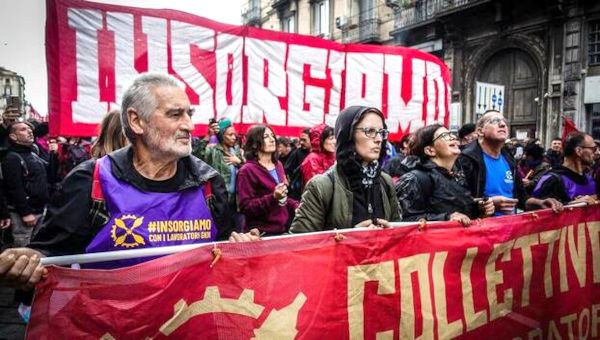Cuba’s Coming Co-operative Economy?
Reflections From Two Recent Field Trips
In 2011, I made two trips to Cuba to study the new co-operatives. In June I was kindly invited by Camila Piñeiro Harnecker, a professor at the University of Havana and one of the country’s leading experts on its co-operative movement, to participate in two conferences. In December, Wendy Holm (Canadian agronomist and co-operative facilitator working in Cuba for the last dozen years) extended an invitation to participate in the “Walking the Walk: Cuba’s path to a more co-operative and sustainable economy” workshops, again in Havana. Both trips had international guests share experiences and knowledge of the co-operative organizational model with our Cuban hosts. The backdrop was, on both occasions, the recently proposed economic reforms coming out of los nuevos lineamientos (the new guidelines) of the Sixth Congress of the Communist Party of Cuba, completed and released on April 18, 2011.
Both of these experiences were eye opening and inspirational, and full of promise for a possible broadening of the co-operative movement in Cuba, while building lasting transnational networks of co-op practitioners and researchers from Cuba and afar. In a nutshell, these trips suggest that Cuba stands on the brink of making a major effort to build a co-operative-based sector. This recalls some of the classic thinking of Robert Owen, William King, George Holyoake, and even Karl Marx, on a co-operative based society. But, undoubtedly, major challenges along this path remain for Cuba, as they have for other state-centred command economies as they entered a period of structural transformation. The following is a report from these field trips and the discussions at the conferences.
Almost instantly upon arriving in Cuba in late June of 2011 I noticed the wherewithal of its people, especially their tenacity to get by on little. In many ways, I discovered, Cubans have already been forging an alternative socio-economic reality for decades now. For instance, we can think of how they revolutionized their agricultural sector during and after the Special Period, making Cuba the first nation to adopt a predominantly organic farming sector rooted in agricultural co-ops and the notion of subsidiarity (i.e., economic activity with a strong focus on the local and managed by local people).
The Potential for a Boom in Co-operatives

The two conferences I presented at in June 2011 were exceptional, if ultimately a bit surprising for me in ways. First, I participated in the “Corporate Social Responsibility, Cooperatives, and Local Development” conference on June 21 with a diverse group of co-op practitioners, social entrepreneurs, and social and solidarity economy researchers from different parts of Latin America and Canada. Organized in part by the University of Havana’s Centre for Studies on the Cuban Economy, a Latin American NGO called Fundación AVINA, and American social entrepreneur Eric Leenson. At this first conference I presented some of the results of my ethnographic and political economic work with Argentina’s empresas recuperadas por sus trabajadores (worker-recuperated enterprises, or ERTs). Many Cuban academics and officials working with co-ops and local development initiatives in attendance seemed to be fascinated with the experiences of workers taking over businesses in trouble in Argentina, based on their comments to me afterwards. They were interested to know more about how to make autogestión (self-management) work in a country that has had no real experience with co-operatives in general outside of agriculture, a sector where they have engaged in promising experiments with Cooperativas de Crédito y Servicio and Cooperativas de Producción Agropecuarias (producer and consumer co-ops in the farming sector also known as CCS and CCP respectively) and Unidades Básicas de Producción Cooperativa (worker-run and state owned co-operatives that service the agricultural sector, known also as UBPC) (Piñeiro Harnecker, 2011a). These Cuban academics and officials I spoke with looked at the experiences of Argentina’s workers starting co-ops from scratch as similar to what many Cubans might have to embark on in the next months and years. This is especially the case, they shared with me, given that hundreds of thousands of Cuban workers will be transitioned from “empleo estatal” (“state employment”) to “empleo no-estatal” (“non-state employment”) over the next few years.
Indeed, the vision of the nuevos lineamientos of the Cuban Communist Party is to increase the non-state employment sector from 16 per cent of Cuba’s workforce (2010 figures) to 35 per cent of Cuban workers by 2015. This would mean that in three years, if this projection holds, Cuba will have 1.8 million non-state workers employed either as cuentapropistas (the self-employed), trabajadores asalariados (salaried workers), or cooperativistas (cooperators) (Piñeiro Harnecker, 2011a).
While many of these new, non-state workers have the potential of eventually working in an expanded, non-rural co-operative sector, they could equally be employed in an expanding private sector. There is room in the economic reforms for a boom in private businesses, as well (sections 11 to 24 of the lineamientos), together with a continuation of “state-funded entities” (sections 30 to 34). Regardless, it is also undeniable that sections 25 to 29 of the lineamientos leave ample room for the potential mushrooming of the co-operative movement. “Grade 1 co-operatives,” section 25 begins:
“shall be established as a socialist form of joint ownership in various sectors. A co-operative is a business organization that owns its estate and represents a distinct legal person. Its members are individuals who contribute assets or labour and its purpose is to supply useful goods and services to society and its costs are covered with its own income.”
While there are, as yet, no guarantees that a boom in “Grade 1 co-operatives” will necessarily emerge, there is growing interest afoot in Cuba to encourage such a new, non-agricultural co-operative sector. The strong language on co-ops in the lineamientos is offering much inspiration to some in this regard. But the interest in co-ops extends far beyond the decrees of the lineamientos. One Cuban professor suggested to me that co-operatives could take over the economy in sectors such as food provisioning, consumer services, housing, and sanitation. Another group of Cuban researchers I spoke with believe that worker co-operatives of all stripes could particularly blossom in areas such as tourism, public transportation, manufacturing, and community services. “In the short term,” reads section 217 of the lineamientos, “the industrial productions shall be re-oriented to meet the demands from different forms of production (particularly co-operatives and self-employees).”
What are some of the lingering concerns amongst some Cubans that aspire to expand the co-operative sector, then? The general answer given to me by co-op developers and researchers was that Cubans lack knowledge in co-operative organizing and values. Yes, they underscored, many Cubans do indeed have experience with agricultural co-ops or urban agricultural co-ops (organopónicos), and most have been involved in “popular power” initiatives, or with community-based committee experiences for some time. But most of these experiences, I was told, have been, up till now, top-down or party-led.
The Cubans I talked with during my first visit in June 2011 wanted mostly to know how to co-operatively organize and practically manage themselves bottom-up, and how to start teaching each other the ins-and-outs of forming co-operatives “from below,” from out of their own initiatives. From Cubans that I spoke with, there is, on the one hand, a pragmatic sense that they must know how to manage themselves better and produce adequately without government quotas and such. At the same time, we discussed and debated how exactly the “non-state” sector might emerge in Cuba, as well as the virtues of co-operatives and the risks of opening up their economy to free markets and outright capital-based and investor-owned firms. During these conversations, I tried to focus on my observation that, given what I know of the explosion of the social and solidarity economy in other parts of Latin America in recent years, Cubans too could make a go of a non-state enterprise sector that still respects key aspects of their socialist project by thinking about “co-operativizing” their economy. This would include co-operative production, co-operative service delivery, co-operative exchange or “markets,” and co-operative banks or credit unions. Moreover, we agreed, this would allow Cubans to hold on to much of the social values and collaborative spirit they already have within their existing version of socialism.
The Potential for a Social and Solidarity Economy
The second conference I presented was at the Centre for Studies on the Cuban Economy (CEEC in Spanish). It was their annual conference of mostly Cuban economists, government officials, and municipal development officials. This conference was a slightly different but equally rewarding experience. There, I gave what I thought was a straightforward conceptual definition of the “social and solidarity economy.” In this presentation, I made an effort to bridge Canadian, European, and Latin American conceptualizations while connecting notions of the social and solidarity economy to actual on-the-ground experiences in Latin America. Drawing from these traditions, in this presentation I defined the social and solidarity economy as:
“…social and economic practices and organizations that are not investor-owned or for-profit entities (although its organizations can make and draw on surpluses), nor government-owned or controlled (although its organizations may receive government funding), and that operate with the values of provisioning, first and foremost, for the socioeconomic needs of members. Known also loosely as the ‘third sector,’ social and solidarity economy organizations tend to have social objectives (such as sustaining and creating jobs, provisioning less expensive or environmentally sound consumer goods and services, facilitating the social or economic capacities of individuals and communities, etc.) and are usually organized in some sort of democratic fashion where each member has a vote or say in the operation, governance, and goals of the firm.”
The Cubans that listened to my presentation were very interested to know more about the social and solidarity economy but seemed not to be as familiar on the whole with a working definition of the concept. This was the case, as some Cuban academics told me, because they haven’t needed such a concept until now with a Cuban state and economy that is already “socialist” and “socialized.” This was surprising to me at first, especially given Cuba’s already-existing social economic practices that in many ways have been part of their daily reality for decades now. Think, for example, of their mostly do-it-yourself and community-based car parts manufacturing and repair shops, or the common practice throughout Cuba of sharing scarce commodities and products amongst neighbours.
Here some rich debates emerged amongst us concerning the terms socialized, social, and socialist; how a social and solidarity economy is different or similar to what Cubans have been practicing under state socialism; and how such conceptualizations of the social and solidarity economy could help Cubans think about a new socialism that connects the broad economic reforms the Party is proposing with the everyday practices of Cuban people. Conceiving of the “non-state” sector as a social and solidarity economy could also prove to be a softer landing for the hundreds of thousands of state workers that are expected to become (without a clear transition plan so far, it seems to me) cooperativistas and cuentapropistas.
Challenges, Tensions, and Possibilities for
a Co-operative Economy in Cuba
The release of the “Draft Guidelines” of the economic reforms in the fall of 2010, and the promising public consultations that were had between December 2010 and February 2011 with over 1 million Cubans in the process of developing the lineamientos, has, most certainly, committed Cuba to a massive reform of the economy such as it has never seen before. Cuba is, in a word, at a crossroads right now. There will definitely be room for a new kind of economy where “non-state enterprises” will be a reality sooner rather than later over the next three to five years. This will include a new Cuban entrepreneurial class, a larger class of cuentapropistas, a much larger class of salaried workers, and – potentially – a substantial social and solidarity economic sector populated by many co-operatives.
Whether a new private sector will dominate the new Cuban economy, or whether Cuba turns primarily to a new socialized economy rooted in co-operatives, remains to be seen. Certainly, Section 1 of the lineamientos (concerning Cuba’s new “Economic Management Model”) leaves interpretive room for either, although the preamble to the lineamientos could arguably align more easily with a social economy made up of co-operatives:
“The economic system that shall prevail will continue to be based on the people’s socialist ownership over the fundamental means of production, governed by the socialist principle of distribution: ‘from each according to his/her capacity to each according to his/her contribution.’”
Whichever way Cuba heads, and based on the open way these economic reforms are being discussed in Cuba right now (including in the daily Granma by the actual Party), these reforms will potentially be broader and more transformative than the reforms that emerged during and immediately after the Special Period in the early 1990s.
Some economists that presented at the CEEC conference, for example, are pushing for the quick introduction of these reforms and talk liberally of increasing the space for cuentapropistas (the self-employed, which also includes entrepreneurs and employers) and allowing for a Cuban-owned and -run private sector that will be able to hire employees other than family members. Indeed, this view is in line with sections 11 to 24 of the lineamientos. Some of the economists I heard, inspired by the Chinese model of economic growth, talk as if some sort of a broader private sector is an unavoidable reality, necessary for the increased productivity and innovation needed in Cuba, they argue, in order to lift it out of its developing country status. The major indicators being used by these economists is economic growth, GDP, investment-to-profit ratios, and so on. This can be straight-up neoclassical stuff and risks putting Cuba on the path of yet one more former socialist country that opens up its economy to unbridled markets. Moreover, the Cuban government is, as I write, also expanding its list of permissible private sector firms.
“But, on the whole, opening up the Cuban economy more and more to straight up capital-labour relations and free markets is, I believe, the most perilous part of the suggested reforms…”
But, on the whole, opening up the Cuban economy more and more to straight up capital-labour relations and free markets is, I believe, the most perilous part of the suggested reforms and what might very well put Cuba’s many socialist gains (i.e., free health care, excellent public education, low poverty rates, low crime rates, virtually no unemployment, subsidized housing, public transportation, etc.) at most risk of eventually evaporating into a market-driven system.
The degree of inter-firm competition that this new economy could involve is particularly unclear. And what of the characteristics of a new wage-based labour market that will be needed to supply employees to private firms, where the labour-power of a new class of “productive” workers would become one of Cuba’s newest commodities and where out-and-out surplus-value extraction and capital accumulation would be the prime mover for more and more privatized firms and economic sectors? Surprisingly, there is very little mention of such basic socialist concepts and critiques from some of the Cuban economists I have heard and read in the past year.
Another set of issues posed by some Cuban economists and co-operative developers is how production inputs will be provisioned in a non-state sector. They realize that some sort of wholesale market will be needed, for instance, but are not clear about its make-up. This has been traditionally handled by state quotas in Cuba. How will the non-state sector adapt to supply and demand constraints? Will a production input and supplies market be driven and regulated by price-indicators for new non-state businesses to capitalize, or will state planning still be maintained there? Both of these scenarios have their downsides for a potential co-operative economy. And what is the role of foreign businesses and suppliers? The issue of what type of consumer markets will emerge is equally vague still. Finally, if the Cuban government’s plan is to transition former state-employees to the new “non-state” economic sector and, in so doing, increase the country’s non-state workers by as much as a fifth by 2015, how exactly will this transition happen and how will the Cuban state guarantee the lineamientos’ and Raul Castro’s repeated assurances that “no one will be left unprotected” in the process?
 All of these questions remain without clear answers to most Cubans I spoke with. But what is clear is that co-operatives will surely be allowed to emerge outside of the agricultural sector as service, consumer, housing, and worker co-operatives. There is, moreover, a pending law of co-operatives that is being written right now, set to be released sometime this year, that should clarify to what degree the government is expecting co-operatives to take a leading role in the new non-state economic sector (Piñeiro Harnecker, 2012).
All of these questions remain without clear answers to most Cubans I spoke with. But what is clear is that co-operatives will surely be allowed to emerge outside of the agricultural sector as service, consumer, housing, and worker co-operatives. There is, moreover, a pending law of co-operatives that is being written right now, set to be released sometime this year, that should clarify to what degree the government is expecting co-operatives to take a leading role in the new non-state economic sector (Piñeiro Harnecker, 2012).
In sum, from the countless conversations I had while in Cuba with academics, government workers, co-operators, and people on the street, many Cubans are very willing to contemplate and consider the role of a larger co-operative sector. There is no doubt that many Cubans are working hard to make this a reality in the coming months and years. My sense is that many – perhaps the majority – of Cubans know that they have too much to lose to go down the neoliberal path, a distinct possibility given the trajectory of other ‘socialist’ command economies, and the structural reforms that are unfolding. The co-operative path to economic sustainability would, I think, be a viable alternative development model for many key sectors of the Cuban economy. Such a development model would keep social wealth within the country and expand the capacities of Cuban workers in self-management. Such activism and participation among workers can also be a key spur to the nature of reforms in crucial areas where large state enterprises will remain, whether fully state owned or in joint enterprises. The co-operative road to reforms, most importantly, could help conserve the successes of Cuba’s brand of socialism, notably its egalitarian education, cultural and health sectors, which remain quite unique across South America and the Caribbean. At the same time, such co-operative-based reforms could help Cuba move along a new path toward 21st century socialism. •
Additional References on Cuba’s new co-operatives:
- Holm, Wendy. (2011). “Report on the outcomes of an informal Havana dialogue between co-op thought leaders from Cuba, Canada, the United States, and Scotland,” 12-16 December.
- Piñeiro Harnecker, Camila. (2011a). Empresas no estatales en la economía cubana: potencialidades, requerimientos y riesgos. Working Paper, Centro de Estudios de la Economía Cubana.
- Piñeiro Harnecker, Camila. (2011b). Y las cooperatives, cuando? Potencialidades de las cooperativas para la actualización del modelo económico cubano, Palabra Nueva, October.
- Piñeiro Harnecker, Camila. (2011c). (Ed.), Cooperativas y socialismo: Una Mirada desde cuba. Havana: Editorial Caminos. [The Spanish preface to the book can be found here. An English preface can be found here. An English translation of the book is forthcoming.]
- Piñeiro Harnecker, Camila. (2012). Ahora que sí van las cooperativas, vamos a hacerlo bien. Rebelión, 2 March.
- Sixth Congress of the Communist Party of Cuba. (2011). Resolution on the Guidelines of the Economic and Social Policy of the Party and the Revolution, 18 April. [The new social and economic lineamientos (guidelines) of the Sixth Party Congress of Cuba.]





